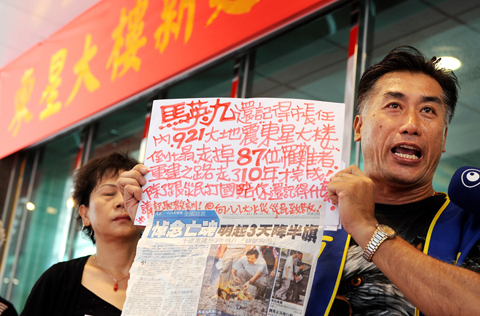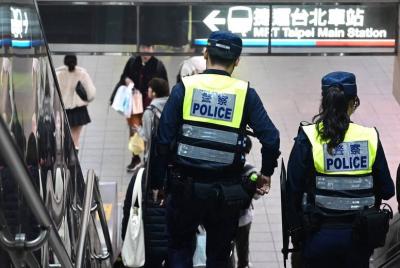In the 10 years since the Tunghsing Building in Taipei City was leveled by the 921 Earthquake in 1999, 68-year-old Mrs. Chien (簡) and most of her fellow residents have been forced to live with relatives or move around while waiting for their home to be reconstructed.
The rebuilding project, which began in 2004 and was suspended twice because of the contractors’ financial problems, was finally inaugurated on Saturday, with more than 70 of the 84 former households preparing to return to the 14-story building at the intersection of Bade Road and Hulin Street.
“I’ve been renting apartments in the vicinity since the earthquake. Ten years is a very long time, and I am glad that I can finally move back home,” she said on Saturday while chatting with old neighbors who gathered to attend the inauguration.

PHOTO: CHIEN JUNG-FONG, TAIPEI TIMES
The memory of the night of the massive earthquake, which killed more than 2,400 people, remains vivid for Chien. She and her husband were sleeping in their 10th floor apartment, and they managed to escape through the air conditioning vents as the whole building collapsed in seconds, she said.
The Tunghsiung Building was the only structure in Taipei City to be completely destroyed by the quake, which was centered about 200km outside the city. Eighty-seven people in the building were killed, 105 injured and more than 250 left homeless in the collapse.
While other collapsed buildings around the country were rebuilt over the years, the road to reconstruction was a bumpy one for Tunghsing’s residents. The project was halted twice after two contractors declared bankruptcy, one in 2006 and the other last year, while a lawsuit filed by survivors against the Taipei City Government was an additional financial burden on those residents.
In 2000, the residents filed a NT$1.5 billion (US$45 million) lawsuit against the city for issuing an operation license to the original contractor despite the building’s substandard construction. Then-Taipei mayor Ma Ying-jeou’s (馬英九) administration refused to admit responsibility for the collapse, but the Taiwan High Court ruled in 2005 that the city must pay NT$330 million to the residents. The city appealed the ruling.
The legal war between the city and the residents remained unsettled until 2007, when Taipei Mayor Hau Lung-bin (郝龍斌) agreed to pay the residents NT$120 million.
Catherine Liao (廖汶錡), director of Tunghsing Building Reconstruction Association, said the residents had mixed feelings about the 10-year reconstruction process, but she declined to comment on the lawsuit.
“We remain thankful for the city government’s administrative assistance,” she said.
Chen Chien-hua (陳建華), a member of Tunghsing Building Self-help Association, however, criticized Ma as indifferent to the residents’ pain and incapable of handling the aftermath of the building’s collapse.
“It took President Ma Ying-jeou 10 years to rebuild the Tunghsing Building. Let’s wait and see how many years he needs to rebuild the areas hard-hit by Typhoon Morakot,” he said.
Chen, who lost his mother and brother in the 921 Earthquake, said the time-consuming lawsuit and the delays in the reconstruction process resulted in a NT$100 million construction surcharge, forcing each household to pay several million NT dollars in addition to their original mortgage.
Liao said about 90 percent of residents had not moved back into building because of paperwork and mortgage issues. The paperwork process and mortgage negotiation with banks and the contractor could take months.
Chien is one of the lucky few who will be moving back in soon. She will be back on the 10th floor, but just with her son because her husband passed away seven months ago.
“My biggest regret is that my husband did not live to see the new building and return home with me,” she said.
Chen said if the former Ma administration had used its power to help facilitate the reconstruction process, instead of challenging the residents in a legal fight, the building would have been rebuilt years ago, saving residents time and money.
Lin Chung-huan (林崇煥), director of the city’s Urban Redevelopment Office, said the city government had given subsidies to the residents and negotiated with the central government to win the residents lower interest rates on their mortgages.
The office will hold a meeting with Ministry of Interior’s Construction and Planning Agency tomorrow to discuss ways to facilitate the remaining paperwork.
When asked about the mortgage issue and the construction surcharge, Lin said the surcharge was caused by the rising price of construction materials in recent years.
“The city government has no responsibility for the mortgages and surcharge. It is the residents’ job to negotiate with the banks and pay the money,” he said.

Beijing could eventually see a full amphibious invasion of Taiwan as the only "prudent" way to bring about unification, the US Department of Defense said in a newly released annual report to Congress. The Pentagon's "Annual Report to Congress: Military and Security Developments Involving the People's Republic of China 2025," was in many ways similar to last year’s report but reorganized the analysis of the options China has to take over Taiwan. Generally, according to the report, Chinese leaders view the People's Liberation Army's (PLA) capabilities for a Taiwan campaign as improving, but they remain uncertain about its readiness to successfully seize

Taiwan is getting a day off on Christmas for the first time in 25 years. The change comes after opposition parties passed a law earlier this year to add or restore five public holidays, including Constitution Day, which falls on today, Dec. 25. The day marks the 1947 adoption of the constitution of the Republic of China, as the government in Taipei is formally known. Back then the Chinese Nationalist Party (KMT) governed China from Nanjing. When the KMT, now an opposition party in Taiwan, passed the legislation on holidays, it said that they would help “commemorate the history of national development.” That

Taiwan has overtaken South Korea this year in per capita income for the first time in 23 years, IMF data showed. Per capita income is a nation’s GDP divided by the total population, used to compare average wealth levels across countries. Taiwan also beat Japan this year on per capita income, after surpassing it for the first time last year, US magazine Newsweek reported yesterday. Across Asia, Taiwan ranked fourth for per capita income at US$37,827 this year due to sustained economic growth, the report said. In the top three spots were Singapore, Macau and Hong Kong, it said. South

Police today said they are stepping up patrols throughout the Taipei MRT system, after a social media user threatened to detonate a bomb at an unspecified station this afternoon. Although they strongly believe the threat to be unsubstantiated, Taipei Metro police and the Railway Police Bureau still said that security and patrols would be heightened through the system. Many copycat messages have been posted since Friday’s stabbing attacks at Taipei Main Station and near Zhongshan MRT Station that left three dead and 11 injured, police said. Last night, a Threads user in a post said they would detonate a bomb on the Taipei